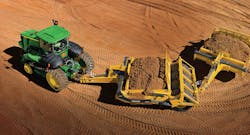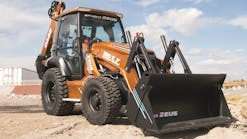Temperature mapping provides the operator with a temperature “map” showing the path of the compactor overlaid with the last recorded surface temperature.
The Density Direct system’s calibration screen enables the user to set the project’s target density. Once fully calibrated with data specific to the application, the Volvo Intelligent Compaction with Density Direct system produces a density calculation accurate to within 1.5% of core sampling, providing a real-time reading of density values for over 100% of the mat.
The operator can use the real-time data to make any necessary adjustments while asphalt is being paved. This is designed to reduce the occurrence of inadequate densities that drive up project costs and reduce time spent taking core samples in an effort to improve quality. It also is designed to lead to greater uniformity than offered through nuclear gauge testing.
Temperature mapping provides the operator with a temperature “map” showing the path of the compactor overlaid with the last recorded surface temperature. The Density Direct system’s calibration screen enables the user to set the project’s target density. Once fully calibrated with data specific to the application, the Volvo Intelligent Compaction with Density Direct system produces a density calculation accurate to within 1.5% of core sampling, providing a real-time reading of density values for over 100% of the mat. The operator can use the real-time data to make any necessary adjustments while asphalt is being paved. This is designed to reduce the occurrence of inadequate densities that drive up project costs and reduce time spent taking core samples in an effort to improve quality. It also is designed to lead to greater uniformity than offered through nuclear gauge testing. [text_ad] Calibration information is saved by the machine, enabling operators to assign calibrations to certain job elements and quickly switch back and forth between calibrations to meet the specific job element demands. Data gathered from pass mapping, temperature mapping, and density mapping is stored on the IC system’s internal 14-GB hard drive for approximately seven months of data logging. Data can be backed up to USB drives in VEDA format, the Freeware system promoted by theFHWA for IC systems. With optional Differential GPS, the data gathered from Volvo IC is linked to location information accurate to within 0.5 inches. Both Volvo IC packages meet state DOT and FHWA requirements for intelligent compaction specifications. Caterpillar’s Machine Drive Power (MDP) is designed to measure soil density under broader conditions with improved accuracy. It is designed to work on all soil types, including fine, granular, and cohesive. MDP is designed to measure the energy necessary to overcome rolling resistance in such a way that is a more tangible and direct measurement of soil stiffness. “In a very loose, lifted soil, it takes a lot of energy to move that roller through that soil,” says Dann Rawls, marketing consultant for Caterpillar’s technology enabled solutions group. “As that dirt becomes more compact and the ground becomes stiffer, it takes less energy to move that machine.” A compactor has to be operating for an accelerometer to read ground stiffness, whereas an MDP system can be put on static rollers, says Rawls. The MDP has been introduced to Caterpillar’s 815 series four-drum compactors. MDP works on smooth drums, pad foot drums, and smooth drums equipped with pad foot shell kits. The system works with the vibe system on or off to enable operators to measure during working passes, and shut the vibe system off for proofing passes. It is scalable to meet requirements. MDP is designed to measure closer to the depth that the machine is able to compact and closer to the thickness of the lift. Its measurements are designed to be more easily correlated to portable measuring devices, such as plate load testing; less affected by the dampening effect of cohesive soils; and not prone to variabilities. Compaction Meter Value (CMV) is an accelerometer-based measurement system for granular soils available on smooth-drum soil compactors (CS models). The system functions while the drum vibrates, measuring 3–4 feet into the ground to provide the operator with a picture of what’s going on beneath the surface. CMV is designed to reveal to a trained operator the location of hidden anomalies such as buried objects, rocks, clay balls, and areas of poor compaction—or indicate the need for more moisture to aid compaction. Wacker Neuson offers a compaction display called Compatec. It is a device used to give the operator live feedback regarding the relative compaction and is designed to aid the operator in avoiding unnecessary passes, says Hunt. Compatec also protects the machine by alerting the operator with flashing LED lights when the machine is operating in an over-compacted situation. BOMAG Economizer, originally developed for BOMAG plate compactors, is one of the newest technologies expanding the company’s tandem roller line. “It offers intuitive operation with real-time compaction results easily read from an LED display on the instrument panel,” says Dave Dennison, marketing manager, BOMAG Americas. “Once the roller’s optimum working frequency has been reached, yellow LED lights indicate thelevel material stiffness. “As compaction increases, more LED lights illuminate on Economizer. When the number of yellow lights stops increasing, the maximum level of compaction has been achieved. If all 10 yellow lights are illuminated, a red LED light illuminates as an indicator to the operator to stop rolling that section. This avoids over-compaction and fracturing of the aggregate, and costly removal and replacement of material.” [text_ad use_post='27747'] Dennison says an added benefit to the Economizer is that it allows the operator to do proof rolling of the area to look for and address weak areas. The Economizer is designed to achieve total surface area compaction control. The Economizer’s value, simple operation, and relatively low cost “are opening the ability to have real-time compaction results to a broader range of contractors,” says Dennison. “It can be used to improve compaction results on a wide variety of applications, from driveways and parking lots to country roads and highways.”Calibration information is saved by the machine, enabling operators to assign calibrations to certain job elements and quickly switch back and forth between calibrations to meet the specific job element demands.
Data gathered from pass mapping, temperature mapping, and density mapping is stored on the IC system’s internal 14-GB hard drive for approximately seven months of data logging. Data can be backed up to USB drives in VEDA format, the Freeware system promoted by theFHWA for IC systems.
With optional Differential GPS, the data gathered from Volvo IC is linked to location information accurate to within 0.5 inches. Both Volvo IC packages meet state DOT and FHWA requirements for intelligent compaction specifications.
Caterpillar’s Machine Drive Power (MDP) is designed to measure soil density under broader conditions with improved accuracy. It is designed to work on all soil types, including fine, granular, and cohesive.
MDP is designed to measure the energy necessary to overcome rolling resistance in such a way that is a more tangible and direct measurement of soil stiffness.
“In a very loose, lifted soil, it takes a lot of energy to move that roller through that soil,” says Dann Rawls, marketing consultant for Caterpillar’s technology enabled solutions group. “As that dirt becomes more compact and the ground becomes stiffer, it takes less energy to move that machine.”
A compactor has to be operating for an accelerometer to read ground stiffness, whereas an MDP system can be put on static rollers, says Rawls. The MDP has been introduced to Caterpillar’s 815 series four-drum compactors.
MDP works on smooth drums, pad foot drums, and smooth drums equipped with pad foot shell kits. The system works with the vibe system on or off to enable operators to measure during working passes, and shut the vibe system off for proofing passes. It is scalable to meet requirements.
MDP is designed to measure closer to the depth that the machine is able to compact and closer to the thickness of the lift. Its measurements are designed to be more easily correlated to portable measuring devices, such as plate load testing; less affected by the dampening effect of cohesive soils; and not prone to variabilities.
Compaction Meter Value (CMV) is an accelerometer-based measurement system for granular soils available on smooth-drum soil compactors (CS models). The system functions while the drum vibrates, measuring 3–4 feet into the ground to provide the operator with a picture of what’s going on beneath the surface. CMV is designed to reveal to a trained operator the location of hidden anomalies such as buried objects, rocks, clay balls, and areas of poor compaction—or indicate the need for more moisture to aid compaction.
Wacker Neuson offers a compaction display called Compatec. It is a device used to give the operator live feedback regarding the relative compaction and is designed to aid the operator in avoiding unnecessary passes, says Hunt.
Compatec also protects the machine by alerting the operator with flashing LED lights when the machine is operating in an over-compacted situation.
BOMAG Economizer, originally developed for BOMAG plate compactors, is one of the newest technologies expanding the company’s tandem roller line.
“It offers intuitive operation with real-time compaction results easily read from an LED display on the instrument panel,” says Dave Dennison, marketing manager, BOMAG Americas. “Once the roller’s optimum working frequency has been reached, yellow LED lights indicate thelevel material stiffness.
“As compaction increases, more LED lights illuminate on Economizer. When the number of yellow lights stops increasing, the maximum level of compaction has been achieved. If all 10 yellow lights are illuminated, a red LED light illuminates as an indicator to the operator to stop rolling that section. This avoids over-compaction and fracturing of the aggregate, and costly removal and replacement of material.”
Dennison says an added benefit to the Economizer is that it allows the operator to do proof rolling of the area to look for and address weak areas. The Economizer is designed to achieve total surface area compaction control.
The Economizer’s value, simple operation, and relatively low cost “are opening the ability to have real-time compaction results to a broader range of contractors,” says Dennison. “It can be used to improve compaction results on a wide variety of applications, from driveways and parking lots to country roads and highways.”








